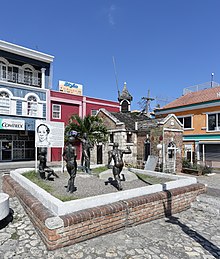Samuel Sharpe

Samuel Sharpe, or Sharp (1801 – 23 May 1832),[1] also known as Sam Sharpe,[2] was an enslaved African Jamaican man who was the leader of the widespread 1832 Baptist War slave rebellion (also known as the Christmas Rebellion) in Jamaica.
He was proclaimed a National Hero of Jamaica in 1975 and his image is on the $50 Jamaican banknote.
Biography
Samuel Sharpe was born into slavery in the parish of St James, Jamaica on a plantation owned by Samuel and Jane Sharpe around 1805. The Slave Return of 1832 announcing his death, gave his name as Archer aka Samuel Sharpe the son of Eve and was only 31 years old when he died. The Slave Return of Samuel and Jane Sharpe 1817 showed a young 12 year old Archer on the plantation with his mother Eve and siblings Joe (2 years old) and Eliza (20 years old). When or why Archer changed his name to Samuel Sharpe is unknown. He was allowed to become well-educated. Because of his education, he was respected by other slaves.
Sharpe became a well-known preacher and leader in the Baptist Church, which had long welcomed slaves as members and recognized them as preachers. He was a deacon at the Burchell Baptist Church in Montego Bay, whose pastor was Rev. Thomas Burchell, a missionary from England. Sharpe spent most of his time travelling to different parishes in Jamaica, educating the slaves about Christianity, which he believed promised freedom.
Baptist War
Slaves earned that the British Parliament was discussing abolition of slavery; those who could read followed such news closely. In the mistaken belief that emancipation had already been granted by the British Parliament, Sharpe organised a peaceful general strike across many estates in western Jamaica to protest working conditions. As this was the harvest of the sugar cane, it was a critical time for the plantation owners: generally the workforce had to work overtime to process the cane quickly at its peak. The Christmas Rebellion (Baptist War) began on 27 December 1831 at the Kensington Estate. Reprisals by the plantation owners led to the rebels' burning the crops.
Sharpe's originally peaceful protest turned into Jamaica's largest slave rebellion. The uprising lasted for 10 days and spread throughout the entire island, mobilizing as many as 60,000 of Jamaica's enslaved population. The colonial government used the armed Jamaican military forces to put down the rebellion, suppressing it within two weeks. Some 14 whites were killed by armed slave battalions, but more than 200 slaves were killed by troops. Afterward more reprisals followed. The government tried, convicted, and hanged many of the ringleaders, including Sharpe, in 1832. A total of 310 to 340 slaves were executed through the judicial process, including many for minor offenses such as theft of livestock.
In the months leading up to his execution, while in jail, Sharpe had several meetings with Rev. Henry Bleby, a missionary, who reported that Sharpe told him: "I would rather go out and die on that gallows, than live a slave."[3] The rebellion and government response provoked two detailed Parliamentary Inquiries. The Jamaican government's severe reprisals in the aftermath of the rebellion are believed to have contributed to passage by Parliament of the 1833 Slavery Abolition Act and final abolition of slavery across the British Empire in 1838.
Legacy
- In 1975, the government of independent Jamaica proclaimed Sharpe a National Hero, with the posthumous title of Rt. Excellent Samuel Sharpe.
- Also in 1975, Sam Sharpe Teachers' College was founded and named in his honor in Granville, a suburb of Montego Bay.
- Sharpe's image is used on the modern Jamaican $50 bill.[citation needed]
- The British jazz saxophonist Courtney Pine (of Caribbean origin) included an instrumental composition 'Samuel Sharpe' as a tribute on his 2012 album House of Legends.[citation needed]
See also
Further reading
- Rodriguez, Junius P. (ed.), Encyclopedia of Slave Resistance and Rebellion. Westport, Connecticut: Greenwood, 2006.
- Reid-Salmon, Delroy, Burning for Freedom: A Theology of the Black Atlantic Struggle for Liberation. Jamaica: Ian Randle Publishers, 2012.
References
- ^ "Jamaican History 4, 1808–1865", The Gleaner.
- ^ "Sam Sharpe Square". Jamaica National Heritage Trust. Retrieved 7 June 2017.
{{cite web}}: Cite has empty unknown parameter:|dead-url=(help) - ^ Bleby, Henry, Death Struggles of Slavery: Being a Narrative of Facts and Incidents Which Occurred in a British Colony, During the Two Years Immediately Preceding Negro Emancipation, 1853.
